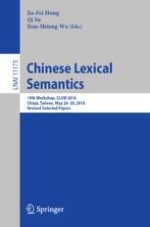2018 | Buch
Chinese Lexical Semantics
19th Workshop, CLSW 2018, Chiayi, Taiwan, May 26–28, 2018, Revised Selected Papers
herausgegeben von: Jia-Fei Hong, Qi Su, Jiun-Shiung Wu
Verlag: Springer International Publishing
Buchreihe : Lecture Notes in Computer Science
